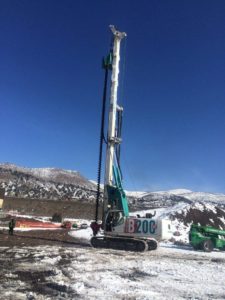 Is your drill rig versatile enough to install a wide range of drilled shaft types? Continuous Flight Auger (CFA) drilled shafts have grown in popularity in recent years—and for good reason. Although they go by several other names (CFA drilled piles, ACIP, and Augercast piles), these CFA shafts are all a type of drilled foundation pile that is progressed into and out of the ground in one continuous flighted auger process, which is concreted or grouted as the tool is removed.
Is your drill rig versatile enough to install a wide range of drilled shaft types? Continuous Flight Auger (CFA) drilled shafts have grown in popularity in recent years—and for good reason. Although they go by several other names (CFA drilled piles, ACIP, and Augercast piles), these CFA shafts are all a type of drilled foundation pile that is progressed into and out of the ground in one continuous flighted auger process, which is concreted or grouted as the tool is removed.
The Benefits of CFA Drilled Shafts
This technique typically does not require any casing and only makes one trip in and out, resulting in faster cycle times from one shaft to the next. The efficient pace is the main attraction of this technique versus a traditional drilled ‘one auger bite at a time’ shaft. However, the CFA drilled shaft requires equipment capable of achieving these advantages. Namely, a balance must be struck between torque, RPM, crowd force, and tooling strength and weights.
Finding the Right Balance
Some contractors believe that drilling down is the biggest challenge of a CFA drilled shaft, but the extraction force of the soils, tools, and overcoming friction in-situ may be the larger limiting factors. For example, to drill a 24”x90’ ACIP pile, the drill rig must overcome approximately 130,000 pounds of force to extract (depending on soil density and tool weight). So, even if your drill can advance the tool to the desired tip elevation, it will also need the extraction capability to remove the tool from the soil. Some equipment suppliers list maximum depths and diameters, but don’t always explain that these physical restraints can often diminish in various soils. In some cases, these numbers are an either/or situation.
The next question is whether you need to apply crowd force and if so, how much. Soils are not always consistent, and not advancing the CFA tool at a steady pace can cause soil subsidence when moving too slow or corkscrewing when moving too fast. To overcome these, applying crowd force via winch and cable can control the rate of advancement to avoid over-excavating the pile or corkscrewing the tool. The greatest advantage of crowd capability lies in its versatility to adjust to all drilling applications. Without enough crowd force, the drill will not be able to perform Full-Displacement Piles or advance in tough soils and rock.
CFA tool rotation is accurately controlled with the proper balance of RPM and torque. Some drillers prefer less torque and mid-ranged RPMs to keep production moving steadily. However, this low torque and high RPM approach leaves the drill rig with little adaptability to perform efficiently in other drilling applications such as displacement, soil mixing, Kelly bar drilled shafts, and casing.
Lastly, the proper tooling makes all the difference. The deeper a shaft penetrates into the soil, the more resistance or friction will act on the tool; it will take more torque to turn that tool the deeper it goes. However, overly ‘strong’ tools meant to handle huge torque loads can be too heavy and add to the extraction weight. Finding the right balance between tool strength and weights can lead to the perfect performance situation.
Trust the Pros
At International Drilling Equipment we are not only equipment distributors, but first and foremost a resource for our customers. Whether you need a dedicated drill rig to simply perform Augercast piles or a multifunctional drill rig capable of handling every application under the sun, IDE can help you find the right equipment mix tailored to your team, your drilling applications, your deep foundation element mix, and your geology. Even if you aren’t an IDE customer, we want to make sure you have all the information needed to make informed decisions. At the end of the day, we want you and the entire foundation drilling industry to be successful. Contact us today to discuss your drilling needs and find out how we can help to optimize even your toughest jobs.

Recent Comments